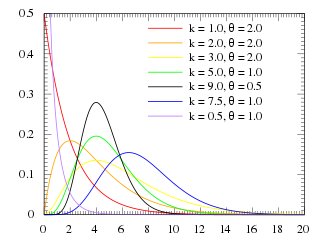User:Yak90
Appearance
| Different texts (and even different parts of this article) adopt slightly different definitions for the negative binomial distribution. They can be distinguished by whether the support starts at k = 0 or at k = r, whether p denotes the probability of a success or of a failure, and whether r represents success or failure,[1] so identifying the specific parametrization used is crucial in any given text. | |||
|
Probability mass function  The orange line represents the mean, which is equal to 10 in each of these plots; the green line shows the standard deviation. | |||
| Notation | |||
|---|---|---|---|
| Parameters |
r > 0 — number of successes until the experiment is stopped (integer, but the definition can also be extended to reals) p ∈ [0,1] — success probability in each experiment (real) | ||
| Support | k ∈ { 0, 1, 2, 3, … } — number of failures | ||
| PMF | involving a binomial coefficient | ||
| CDF | the regularized incomplete beta function | ||
| Mean | |||
| Mode | |||
| Variance | |||
| Skewness | |||
| Excess kurtosis | |||
| MGF | |||
| CF | |||
| PGF | |||
| Fisher information | |||
| Method of moments |
| ||
The negative binomial distribution also arises as a continuous mixture of Poisson distributions (i.e. a compound probability distribution) where the mixing distribution of the Poisson rate is a gamma distribution. That is, we can view the negative binomial as a Poisson(λ) distribution, where λ is itself a random variable, distributed as a gamma distribution with shape = r and scale θ = p/(1 − p) or correspondingly rate β = (1 − p)/p.
| Different texts adopt slightly different definitions for the negative binomial distribution. They can be distinguished by whether the support starts at k = 0 or at k = r, whether p denotes the probability of a success or of a failure, and whether r represents success or failure,[1] so it is crucial to identify the specific parametrization used in any given text. | |||
|
Probability mass function  The orange line represents the mean, which is equal to 10 in each of these plots; the green line shows the standard deviation. | |||
| Notation | |||
|---|---|---|---|
| Parameters |
r > 0 — number of failures until the experiment is stopped (integer, but the definition can also be extended to reals) p ∈ (0,1) — success probability in each experiment (real) | ||
| Support | k ∈ { 0, 1, 2, 3, … } — number of successes | ||
| PMF | involving a binomial coefficient | ||
| CDF | the regularized incomplete beta function | ||
| Mean | |||
| Mode | |||
| Variance | |||
| Skewness | |||
| Excess kurtosis | |||
| MGF | |||
| CF | |||
| PGF | |||
| Fisher information | |||
|
Probability density function  | |||
|
Cumulative distribution function  | |||
| Parameters |
| ||
|---|---|---|---|
| Support | |||
| CDF | |||
| Mean | |||
| Median | No simple closed form | No simple closed form | |
| Mode | |||
| Variance | |||
| Skewness | |||
| Excess kurtosis | |||
| Entropy | |||
| MGF | |||
| CF | |||
- ^ a b DeGroot, Morris H. (1986). Probability and Statistics (Second ed.). Addison-Wesley. pp. 258–259. ISBN 0-201-11366-X. LCCN 84006269. OCLC 10605205. Cite error: The named reference "DeGrootNB" was defined multiple times with different content (see the help page).













![{\displaystyle r={\frac {E[X]^{2}}{V[X]-E[X]}}}](https://wikimedia.org/api/rest_v1/media/math/render/svg/9574276fc676473c29b7f96d37f03fcfddade97f)
![{\displaystyle p={\frac {E[X]}{V[X]}}}](https://wikimedia.org/api/rest_v1/media/math/render/svg/81d5eecaa4e727205ca73ed994aa339714356798)

















![{\displaystyle \operatorname {E} [X]=k\theta }](https://wikimedia.org/api/rest_v1/media/math/render/svg/1de278e52334689991d93625f47897bf0b508601)
![{\displaystyle \operatorname {E} [X]={\frac {\alpha }{\beta }}}](https://wikimedia.org/api/rest_v1/media/math/render/svg/6f99b7dbc2927cef4a361495ba94743c51723c22)













